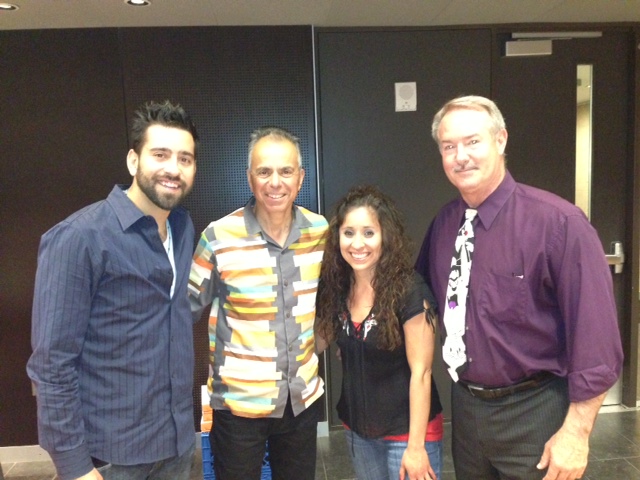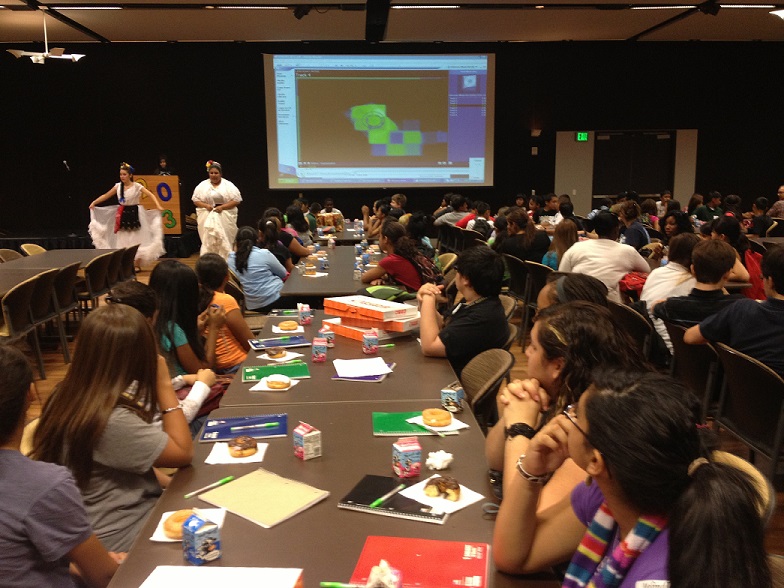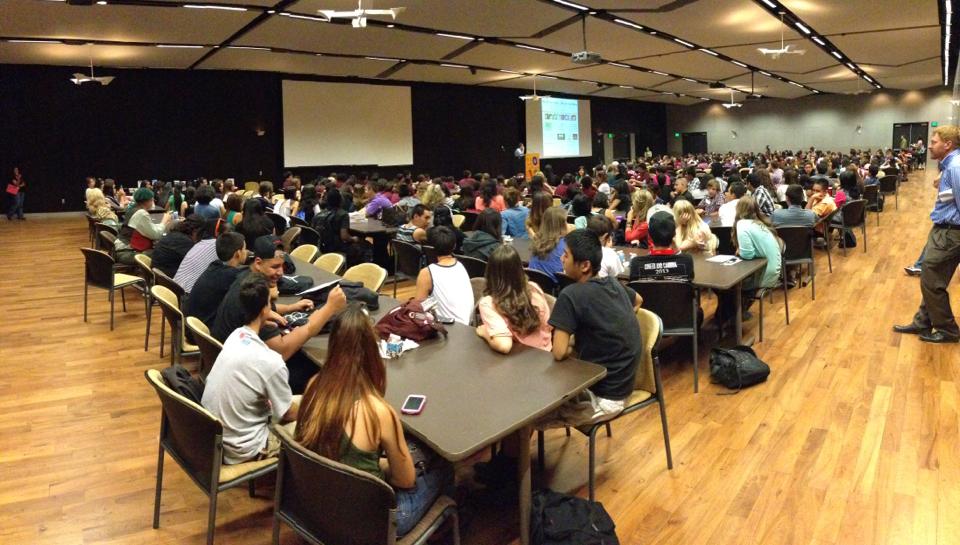Interview with the 2013 Mora Award Winner

For the third year, I’m honored to interview the winner of the Estela and Raúl Mora Award on my blog. Congratulations, Dr. Jim Blasingame and Tracey Flores, to you and the English Education Program at Arizona State University/Tempe. I was inspired by every application I read, but I don’t select the winner nor the Honor Awards started last year.
Libraries all over the country are curious to know what you did that prompted the REFORMA Mora Award Committee to select your library as the 2013 winner. Deep thanks for designing an April Día celebration that teaches us all that by involving community members in planning the event, together you created a memorable campus and community celebration.
Begin by briefly introducing yourselves and your program.
My name is Tracey Flores and I’m currently a doctoral student in English Education at ASU. Before entering this program full-time, I taught for 8 years in Phoenix and Glendale.
And I am James Blasingame, Associate Professor and Director of Secondary English Education in the College of Liberal Arts and Sciences at Arizona State University.
1. How did you first become interested in Día and how long ago was that?
Pat Mora has always been one of our favorite poets. When My Own True Name: New and Selected Poems for Young Adults (2000, Piñata Books) came out, we featured a review of the book and an interview with Pat in Dr. Blasingame’s column in the International Reading Association’s Journal of Adolescent and Adult Literacy. We have spread the word in Arizona K-12 classrooms that these poems and others by Pat are golden! As a classroom teacher, Ms. Flores had heard about libraries, schools, and community organizations hosting El Día celebrations across the country. The celebrations were colorful and lively events that celebrated and honored kids while providing them access to books. She loved the idea and was VERY interested in bringing this event to her local school, but it never came to fruition.
Then, 4 years ago at NCTE in Florida, with the excitement and energy that comes with attending a National Conference full of invigorating presentations and dynamic speakers, Ms. Flores and Dr. Blasingame started talking about hosting an El Día celebration on the ASU Tempe Campus. We wanted to create a space that celebrated children, language, culture, and literacy for AZ and in that moment we decided it needed to happen.
When we returned to AZ from the conference, we immediately started planning the very first ASU El Día for that upcoming April, 2011.
2. When did you begin to plan your 2013 celebration? Did you work with a team and, if so, who created the team? Was having a team helpful? Challenging?
Planning for El Día 2013 started immediately following our 2012 celebration. We booked rooms on campus, created a “dream team” of authors, and started reaching out to people in the community and across campus to present and share their talents.
Our El Día celebration is very much a collaborative team effort. There are a number of people who come together to ensure the event is a success. From our ASU student and faculty presenters, local authors, the English Department Business Office, to our volunteers, every single person is vital in the implementation of our day.
Local authors Tom Leveen, Aprilynne Pike, Bill Konigsberg, Angela Morrison, and Janette Rallison have been advocates of our celebration since the implementation of our very first event. They are always willing to volunteer their time to share their expertise with our guests. English Education Doctoral Students and University faculty and staff have facilitated literacy workshops for our guests and helped with day-of needs in many ways.
Over the years funding and material support has come from various sources, including Dunkin’ Donuts, Shamrock Farms, Phoenix Book Company, Arté Público, ASU Project Humanities, ASU English, ASU English Education, ASU College of Liberal Arts and Sciences, Teaching Foundations/ASU Next, and the Central Arizona Writing Project, and we hope to find additional funders in the community.
A lot of work is done behind the scenes. We are so blessed to have a group of supporters and advocates who believe in the power of this celebration and seamlessly work together to make sure it is the best experience for student guests and their teachers. The English Education program administrative assistant, Tina Norgren, does a mountain of preparation.

L to R: Myrlin Hepworth, Gary Soto, Tracey Flores, Dr. James Blasingame
3. What do you think made your 2013 celebration special?
2013 was our first Día celebration that focused on students in grades 6-12. In the past, we have celebrated with students in K-12, but for this celebration, we decided to really focus our energies in creating a space that honored the voice of the adolescent reader and writer. This is a very unique time in their lives, one in which they are finding out more about who they are and the kind of person they want to be, and through reading and writing, they can explore their world and realize their lives in new ways.
The idea of sharing your story, letting your voice be heard and envisioning a world full of possibilities was threaded into each and every part of the day. Our featured authors often spoke about how they came to discover their “own true names,” as Pat Mora puts it: their own identities. All of our presenters wove this thread into their presentations—and illustrated their support for our guests through their actions and words. It was very uplifting.
We think this day was so special because we came together as one community to empower and inspire our young readers and writers to share their gifts and talents.

4. How do you and your program and your department feel about winning the Mora Award?
We are humbled to be recognized by the committee as having created an exemplar El Día celebration. There are so many amazing celebrations taking place all over the country and we are blessed to be part of a larger El Día tradition. Our department is committed to enabling the voices of all members of our Arizona community, and this provides us with more fuel to stoke our fire.
5. What did you learn from your celebration this year?
This celebration was our largest celebration yet, serving over 500 students and teachers. We learned that if you put your mind and heart into making an idea bigger and better—it can and will happen. We also learned that diverse activities, from dancing, to storytelling, to hip hop poetry come together to weave a beautiful tapestry of heritage.
6. What three key pieces of advice would you give to those ready to plan their first Día celebration in spring 2013? Advice to those who have celebrated before?
This event is about celebrating and honoring children. With all the details that go into implementing El Día it is important not to lose sight of the most important detail of the day and that is the children. Always keep them at the heart of your El Día event. Remember to involve as many community stakeholders as you can, and don’t be afraid to ask them for their support, financial or otherwise. Last year we were assisted in a variety of ways by everyone from Dunkin’ Donuts to Univisión Televisión. And don’t forget the older generations, especially storytellers.
7. Why are Día and sharing bookjoy important to you?
We believe in celebrating Día because it is a time to honor children of all cultures and languages. Through Día we are able to connect with children from across AZ and provide them access to multicultural authors, interactive reading and writing workshops, and the ASU Tempe Campus. This celebration has the GREAT potential to inspire and transform their ideas about the importance of reading and writing every day. Arizona has a beautiful rainbow of diversity, and this is one day to let it glow.
8. You are the first university to win the award. I so hope that you plan to be creative and committed leaders inspiring other universities and community colleges to include Día in their literacy and/or leadership initiatives. If yes, how will you do that?
We plan on sharing our Día celebration at local and national conferences. We will create a website, including a how-to, and we will also write an article for submission to a variety of publications. We hope to be on television again this year, as well.

Pingback:A busy month for Mora Award winners - Pat Mora